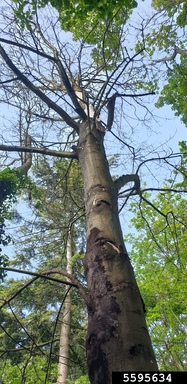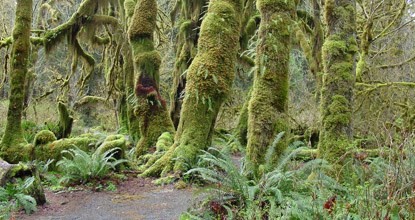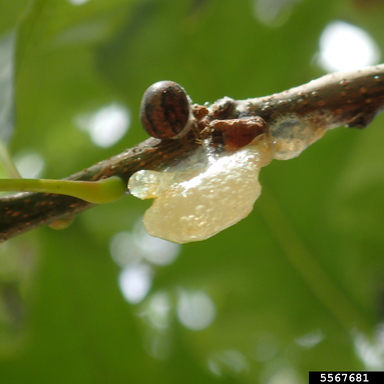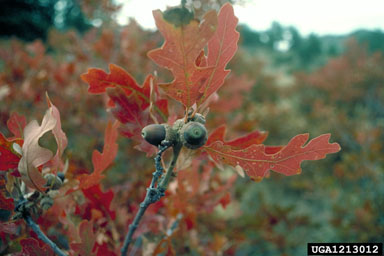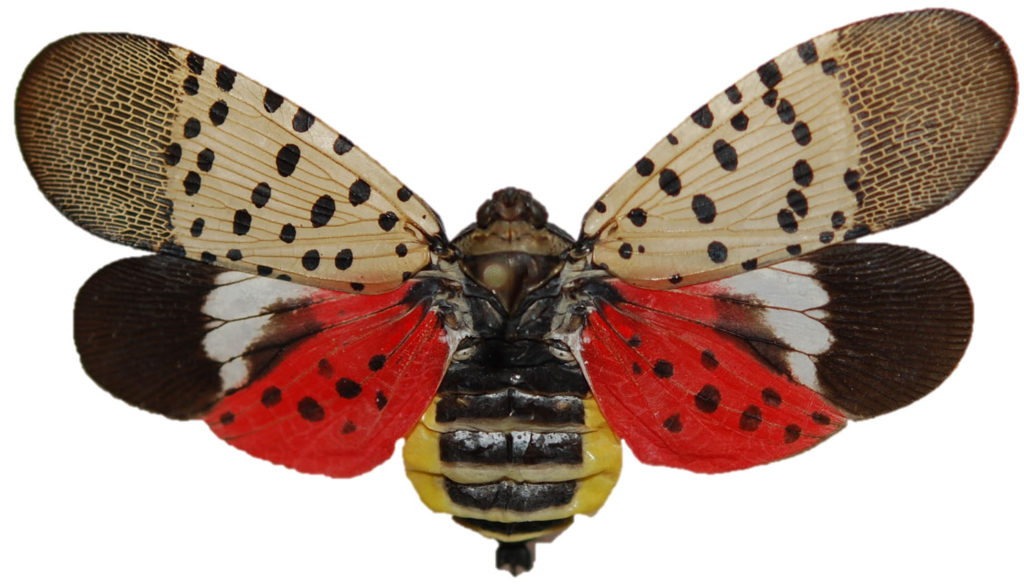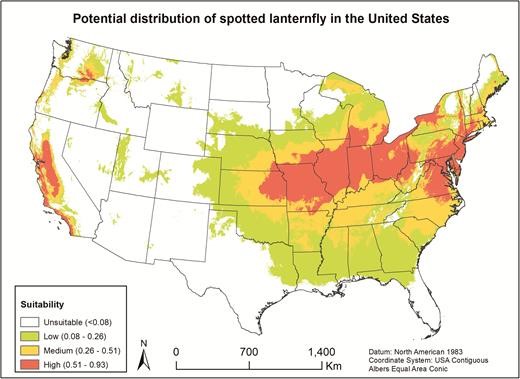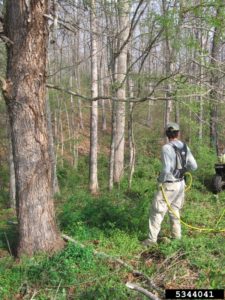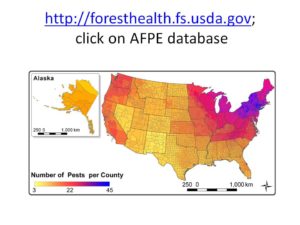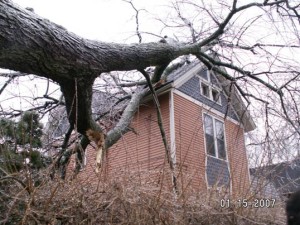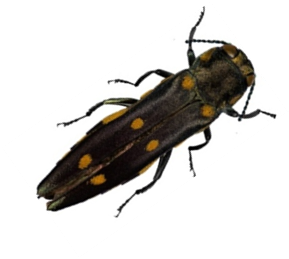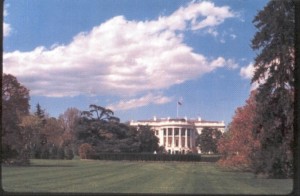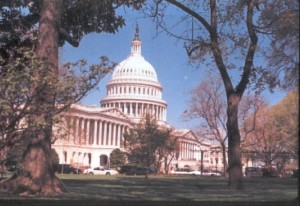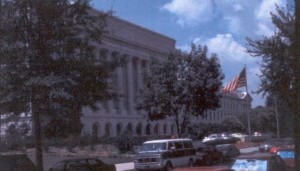Recently, plant pathologists have paid more attention to pathogens — native to eastern North America — now killing trees on the West Coast. Years ago, the likelihood of such “domestic invaders” was hotly debated. However, these new detections provide examples of native micro-organisms that are apparently benign in the ecosystems in which they evolved, but that cause disease when moved to relatively nearby — but naïve — environments. I would argue that it is the absence of co-evolution of pathogen and host, not distance, that matters. In both cases, environmental stress on the trees appears to play a significant role. Such stress is expected to increase as the climate changes.
[In the past, these issues arose re: goldspotted oak borer – introduced to California from Arizona; and thousand cankers disease – introduced from Arizona to Western states and now to the East.]
Little is known about these diseases. So far, scientists have examined the pathogens’ impacts more thoroughly on plantings that are introduced to the location, so already outside of the forest biomes in which they evolved. Less attention has been paid to hosts native to the regions newly affected. I find this disturbing because I am most concerned about the possible impact to native ecosystems.
I will describe two such diseases. Both attack native tree species, not just the exotic trees described in research. Both were first detected in the Pacific Coast states in the late 1960s – i.e., more than 50 years ago. Why are they becoming prominent now – is it changes in the climate? Evolution? Just slow adaptation?
Example One – Sooty Bark Disease
Sooty-bark disease (Cryptostroma corticale) of maples (Acer spp.) is native to the Great Lakes region, where it causes no problems. However, it has been introduced to the West Coast, where all sources agree that the disease kills trees stressed by heat and drought. These stresses are expected to increase as the climate changes. The disease is also a serious threat to human health. The fungus’ spores can cause serious pulmonary disease in humans.
Sooty bark disease was detected in Pullman, Washington, near the Idaho border, in 1968. Now it is more widespread: it was detected in the Seattle area as of 2020 and the Sacramento area of California in 2019 [Curtis Ewing pers. comm.]. Sooty-bark disease has also spread to at least ten countries in Europe, ranging from the United Kingdom to Italy and Bulgaria.
Sources in Washington say hosts include several non-native species widely planted in the area – sycamore maples (Acer pseudoplatanus) [Chastagner], Norway maples (Acer platanoides), Japanese maple (A. palmatum), and horsechestnut (Aesculus hippocastanum) [Chastagner and Washington State University]. More troubling is the fact that several native tree species are also hosts. Big leaf maple (A. macrophyllum), and Pacific dogwood (Cornus nuttallii) are among the most significant. [Big leaf maple is a large hardwood tree in a region dominated by conifers. Pacific dogwood has already been decimated by the introduced disease dogwood anthracnose.] Sources in California add two other maples, these native to eastern North America, red (A. rubrum) and silver (A. saccharinum) maples.
The fungus initiates infection in a tree’s small branches, then spreads into the heartwood and both up and down the tree. It might also invade pruning wounds. The fungus grows more rapidly at higher temperatures. It is also facilitated by drought stress. When the fungus grows out to the bark, it causes the bark to blister; it then forms spore-forming structures. The spores are dispersed by wind. (Chastagner)
Washington State University’s Ornamental Plant Pathology division has called for more research on all aspects of the disease in trees:
- Distribution and spread of the disease;
- Plant species susceptibility and host range;
- Diagnostic methods and molecular approaches to improve diagnostic efficiency and capacity;
- Pathogen life history and genetic diversity;
- Factors that affect disease development and vulnerability (site, stress, age of host, etc.);
- Potential of human mediated dispersal and vectors such as pruning tools;
- Best management practices and worker protection.
So far, little has been done. Scientists in the Pacific Northwest have received a small amount of funding from the USDA Forest Service Forest Health Protection Emerging Pests program link + blog on appropriations to increase diagnostic services and to surveys trees elsewhere in the Puget Sound region.
Example Two – Bacterial Pathogen on Oaks
There is always concern about threats to oaks (Genus Quercus) because of their ecological, economic, and social importance. As Kozhar et al. point out, this genus is one of the most important groups of trees in many regions of the Northern Hemisphere. In North America specifically, oak forests compose a significant part of many forest ecosystems, especially in the East. California has 20 native species, Colorado has one. In addition, oaks are also often planted as shade trees in urban environments, which has resulted in movement of oak species to new geographic areas. There where they experience different environmental conditions, they might find new pests or alert us to the effects of climate change.
The bacterial oak pathogen Lonsdalea quercina is indigenous to the native range of northern red oak (Quercus rubra) in eastern North America. There, it does not cause disease in its co-evolved host. However, it has recently caused two outbreaks in the West – in California and Colorado. In the latter, trees themselves can die; in the former, acorns are damaged, threatening forest regeneration. Other Lonsdalea species have caused similar tree diseases in Europe.
California
In California, the bacterium has been present since at least 1967. It infects acorns of native oaks, including coast live oak (Q. agrifolia), Q. parvula (presumably the mainland subspecies, also named Q. p. var. shrevei),and interior live oak (Q. wislizeni). The Morton Arboretum link says Q. parvula (presumably – again – the mainland subspecies) is currently threatened by sudden oak death (SOD). Coast live oak has also been highly affected by sudden oak death (SOD), DMF but it is not considered to be threatened. I expect – but sources don’t say – that the bacterium is affecting these species’ reproduction.
Various genotypes of L. quercina are randomly distributed across trees in both native and human-altered habitats and among all host species. Kohzar et al. say this is not surprising since all the host oak species are native to the region. Coast live oak is a major component of native forests and is also widely planted as a shade tree in residential areas. Furthermore, there has been no attempt to restrict the pathogen’s movement by adopting quarantines or other measures by phytosanitary agencies.
As a result, the inoculum can be moved across large distances by insects, birds, small mammals, and humans.
Bacterial pathogens can be associated with insects, relying on their feeding sites and other wounds to facilitate entry to the host’s tissues or for dissemination among hosts. In California, L. quercina might enter host tissue via wounds made by acorn weevils, filbertworms, and some cynipid wasps Kohzar et al.).
Colorado
The situation in Colorado is different. Significant dieback of exotic oaks planted in the state came to attention in the early 2000s. The hosts include non-native northern red oak, pin oak (Q. palustris), and Shumard oak (Q. shumardii). In Colorado, the bacterium causes “drippy blight disease” on the trees, not the acorns. The disease causes abundant ooze on symptomatic tissue. There has been a significant increase in tree mortality – with associated removal costs. The bacterium also has been found attacking Colorado’s one native oak, Q. gambelii; in this case, the pathogen attacks the acorns rather than the tree.
Due to small sample sizes, Kohzar et al. were unable to answer three key questions:
- whether the Colorado L. quercina population comprises a new taxonomic species;
- whether genetic variation in the bacterial populations are explained by the habitat (native or human-altered) or host; and
- whether the L. quercina infections on native Q. gambelii serves as an inoculum reservoir for planted Q. rubra hosts or vice versa.
Surprisingly, despite its more recent emergence, the Colorado population of L. quercina has higher genetic diversity. Kohzar et al. suggest this might be due to repeated introductions of the bacterium on nursery stock brought in from the northern red oak’s native range in the East. [see below]
As in California, L. quercina infections are associated with insects, especially kermes scale (Allokermes galliformis). This insect does not travel long distances, which might help explain why the Colorado genotypes are limited to nearby trees, not dispersed randomly as in California.
However, kermes scale has been present in the state for far longer than the disease. The scale’s population spiked at the same time as the drippy blight outbreak was detected. Kohzar et al. could not determine whether the rise in scale populations and associated increase in number of entry points through feeding sites led to the increase of bacterial populations, or vice versa.
Kohzar et al. did determine that the Colorado populations of L. quercina were not introduced from California. They cannot explain the original introduction but think there might be continuing introductions from the native range of both northern red oak and L. quercina – the northeastern United States. They call for further studies to understand evolutionary relationships among L. quercina populations from different areas, including the native habitat of red oak in the East to clarify possible causes and sources of the recent outbreak of drippy blight in Colorado.
Role of Environmental Conditions
Kohzar et al. stress the importance of factors other than species’ introductions to new environments as the cause of emerging forest diseases. They say such other factors as changes in environmental conditions, new host-vector associations, cryptic disease agents (e.g., pathogens with a very long latency period or endophytes changing their behavior to pathogenic), hypervirulent strains of known pathogenic species, and/or newly emerging species of unknown origin as key factors leading to disease emergence in forest ecosystems around the globe.
In the case of L. quercina in California and especially Colorado, Kohzar et al. point to stress on the trees caused by new environmental factors, e.g., rapid climate change. [Of course, oaks from humid regions of eastern North America are already outside their natural habitat in much-dryer Colorado.] They support this conclusion by noting the simultaneous appearance of four new diseases caused by Lonsdalea species in different parts of the world during the 1990s and early 2000s. These were Lonsdalea quercina in Colorado; L. britannica on oaks in Great Britain; L. iberica in Spain; and L. populi bark canker on poplar species in Hungary, China, and Spain. All cause similar symptoms of drippy blight disease.
SOURCES
Chastagner, Gary. Professor, Plant Pathology, Washington State University. https://pnwhandbooks.org/plantdisease/host-disease/maple-acer-spp-sooty-bark-disease
Ewing, Curtis. Entomologist, CalFire. Pers. comm. March 2023.
Kozhar, O., R.A. Sitz, R. Woyda, L. Legg, J.R. Ibarra Caballero, I.S. Pearse, Z. Abdo, J.E. Stewart. 2023. Population genomic analysis of an emerging pathogen Lonsdalea quercina affecting various species of oaks in western North America. BioRxiv https://www.biorxiv.org/content/10.1101/2023.01.20.524998v1
Washington State University Ornamental Plant Pathology https://ppo.puyallup.wsu.edu/sbd/
Posted by Faith Campbell
We welcome comments that supplement or correct factual information, suggest new approaches, or promote thoughtful consideration. We post comments that disagree with us — but not those we judge to be not civil or inflammatory.
For a detailed discussion of the policies and practices that have allowed these pests to enter and spread – and that do not promote effective restoration strategies – review the Fading Forests report at http://treeimprovement.utk.edu/FadingForests.htm
or
